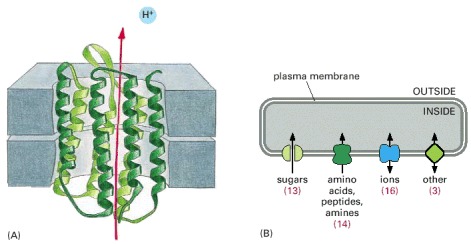From: The Universal Features of Cells on Earth

NCBI Bookshelf. A service of the National Library of Medicine, National Institutes of Health.

(A) Structure of a molecule of bacteriorhodopsin, from the archaean (archaebacterium) Halobacterium halobium. This transport protein uses the energy of absorbed light to pump protons (H+ ions) out of the cell. The polypeptide chain threads to and fro across the membrane; in several regions it is twisted into a helical conformation, and the helical segments are arranged to form the walls of a channel through which ions are transported. (B) Diagram of the set of transport proteins found in the membrane of the bacterium Thermotoga maritima. The numbers in parentheses refer to the number of different membrane transport proteins of each type. Most of the proteins within each class are evolutionarily related to one another and to their counterparts in other species.
From: The Universal Features of Cells on Earth

NCBI Bookshelf. A service of the National Library of Medicine, National Institutes of Health.